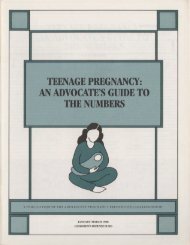child care - Digital Library Collections
child care - Digital Library Collections
child care - Digital Library Collections
You also want an ePaper? Increase the reach of your titles
YUMPU automatically turns print PDFs into web optimized ePapers that Google loves.
FAMILY<br />
INCOME<br />
lent of the minimum wage and must be protected<br />
against unsafe or discrimina~ory practices. Congressional<br />
efforts to deny these protections to<br />
TANF workers were unsuccessful in 1997, although<br />
they may resurface in 1998. If single-parent<br />
families do not receive enough in TANF (plus food<br />
stamps, at state option) to equal 30 hours at the<br />
minimum wage, states must either pay them more<br />
or reduce the number of hours they are required to<br />
work. If states reduce the required hours, these<br />
families will not count toward the federal work<br />
participation rates.<br />
The Effects of Welfare Changes:<br />
Putting More Children at Risk<br />
How has life changed for the millions of<strong>child</strong>ren<br />
affected by the 1996 welfare law? It is still too<br />
early to tell precisely, but the new rules for<br />
welfare recipients, immigrants, and <strong>child</strong>ren with<br />
disabilities put needy <strong>child</strong>ren in a more precarious<br />
position than ever.<br />
The plight of families pushed off welfare. Placing<br />
work requirements on families without offering<br />
them the services they need to comply will force<br />
them off the caseload, imposing far greater hardship<br />
on <strong>child</strong>ren and families. As the most employable<br />
parents fmd jobs, those remaining in TANF<br />
are even more likely to suffer from debilitating<br />
problems.<br />
Oregon, with a caseload drop of 54 percent<br />
between 1993 and 1997, now fmds that a majority<br />
of families remaining in its TANF program are<br />
seriously troubled. Oregon estimates that 75 percent<br />
of its parents on welfare have mental health<br />
problems, 50 percent have substance abuse problems,<br />
and 50 percent are subject to violence. The<br />
state has been willing to provide appropriate services,<br />
and it counts mental health counseling, for<br />
example, as an allowable activity on the path to job<br />
readiness. Utah has taken a similar approach, conducting<br />
individualized assessments and creating<br />
self-sufficiency plans with parents. These plans<br />
may include activities such as literacy training, substance<br />
abuse treatment, or getting a driver's license<br />
if they are seen as moving the individual toward<br />
successful job placement.<br />
Parents who do fmd jobs are in most cases<br />
unable to secure incomes above the poverty level.<br />
Of the fust 40 Virginia families hitting their twoyear<br />
time limit on the receipt ofcash assistance, 35<br />
had jobs, but only eight were Living above the poverty<br />
level. Nationwide about half the parents on<br />
welfare lack high school diplomas, and their income<br />
potential is not good. Two-thirds (64 percent)<br />
of all single mothers who have not fmished<br />
high school live with their <strong>child</strong>ren below the poverty<br />
Line, according to the Census Bureau. The<br />
future holds little promise of rising wages for parents<br />
leaving welfare. Brookings Institution economist<br />
Gary Burtless reports that young women who<br />
began the 1980s on welfare and later worked received<br />
real pay raises averaging only 6 cents per<br />
hour per year by 1990.<br />
Comparing women of similar backgrounds<br />
over a lo-year period reveals some significant differences<br />
between those who receive welfare at<br />
some point and those who don't. In 1997 the Urban<br />
Institute analyzed data on women ages 18-27<br />
from the National Longitudinal Survey of Youth<br />
and found that 45 percent of the welfare participants<br />
had not completed high school, compared<br />
with only 10 percent of women not on welfare.<br />
One-third of mothers who had received welfare had<br />
basic skills at the third-grade level; only 6 percent<br />
of nonrecipients had comparably low skills. Most<br />
significantly, only 24 percent of mothers who had<br />
received welfare at some point found jobs paying<br />
$8 an hour or more.<br />
Difficulty in securing well-paying work is not<br />
the only problem facing families leaving welfare.<br />
The GAO study mentioned earlier found that those<br />
who lost cash aid tended also to lose food stamps<br />
and Medicaid, even though the great majority of<br />
families remained eligible for this support. In Wisconsin<br />
84 percent ofthe families had received food<br />
stamps before termination; afterward only 56 percent<br />
continued to do so. Similarly, 100 percent of<br />
these Wisconsin families had received Medicaid<br />
before losing their cash aid; afterward that number<br />
fell to 53 percent.<br />
CHILDREN'S DEFE SE FUND 11














